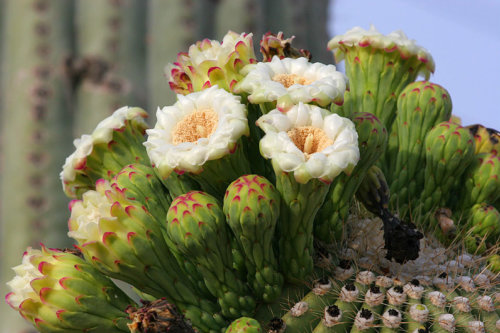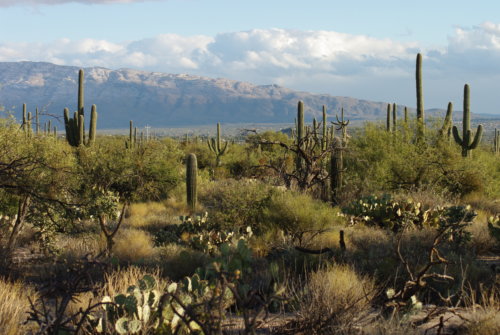Getting to Know the United States’ Biggest Cactus
Like Joshua trees— which are found only in certain parts of the Mojave desert and outlying areas–, the Saguaro cactus (Carnegiea gigantic) grows only within the confines of the Sonoran Desert in the Southwest of the United States. As the largest cactus in the United States, the Saguaro cactus (pronounced “Sah-wah-ro”) has an iconic look about it. With its tall, branched arms it looks like something straight out of an Old West cartoon– an upside-down cowboy, spurred and rendered bow-legged by long days in the saddle.
Historically, the cactus has been an important part of life for the Tohono O’Odham— the area’s indigenous tribe– who view the Saguaro cactus not just as a plant, but as a member of their tribe. Beyond its staggering stature (Saguaro cacti can grow between 40 and 60 feet tall) and their impressive longevity (they typically live between 150 and 200 years– but many scientists estimate there may be even older ones), the Saguaro cactus also produces a wide, white flower (the state flower of Arizona) and an edible fruit (which the Tohono O’Odham call bahidaj). The fruit ripens during the hot summer months, and is harvested with long sticks with a cross at the end, after which it is transformed into an incredibly rare syrup (bahidaj sitol) that is used in similar situations as a fine balsamic vinegar.
Like Joshua trees, who have a rather unfortunate fate before them (many scientists believe the structural ecosystems necessary for the promulgation of Joshua trees have vanished, and that the tree itself will eventually come to a similar end), the Saguaro cactus lives a somewhat threatened existence– though their dangers have a much more human face.
As the largest cactus in the United States, the Saguaro cactus (pronounced ‘Sah-wah-doh’) has an iconic look about it. With its tall, branched arms it looks like something straight out of an Old West cartoon…
Currently, the biggest threats to the Saguaro cactus are poaching and vandalism; Saguaro cacti are a highly sought-after black market commodity (being caught illegally poaching a Saguaro cactus has led to sentences with jail time). Saguaro cacti grow incredibly slowly–it can take up to ten years for a cactus to reach one inch in height– and their seeds are dispersed by bats– an increasingly threatened species. Added to all this is the Saguaro cacti’s tenuous location: many of the cacti sit along contested parts of the US-Mexico border, which has proven a disaster for the Tohono O’Odham who live in the area.
Fortunately, Saguaro cacti have plenty of fans dedicated to their preservation (and not just those who want to illegally import them). Among their staunch advocates is Jack Dykinga, a Pulitzer Prize winning photojournalist who worked to create the 50,000 acre Sonoran Desert National Monument, whose work has famously captured the Saguaro cactus in all its sharp, sunlit glory– images that demonstrate with their striking beauty just how precious the species has become.




































